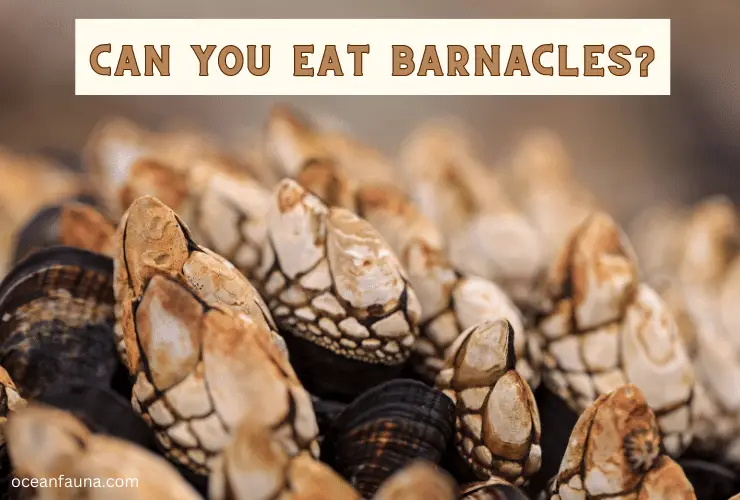Yes, barnacles can be eaten as a type of seafood and are said to be tasty. However, not all species are edible. Despite often being considered sea pests, they can be harvested like other seafood.
This article will provide additional information on how to prepare it and what it tastes like. Let’s get started.
Can You Eat Barnacles?
As mentioned previously, you can eat barnacles, which are considered a delicacy in many parts of the world. These crustaceans may look like small rocks or shells attached to rocks or docks, but they are, in fact, slow-growing creatures that feed on plankton and other tiny organisms.
Before consuming barnacles, ensure that they are harvested from clean and non-polluted waters. However, it is advisable not to consume them in large quantities as they may contain high levels of heavy metals and contaminants.
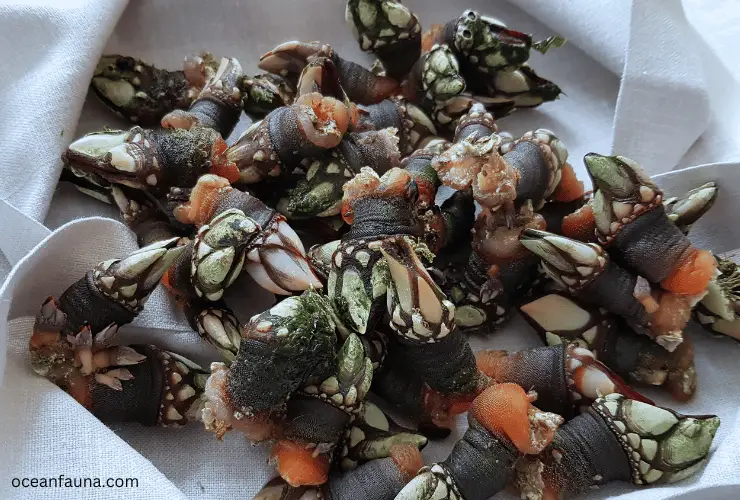
There are various ways to prepare barnacles for consumption. One of the most popular ways is to simply steam them until the shells open up, revealing the soft meat inside. The meat can be dipped in various sauces or simply eaten with lemon juice or garlic butter.
In many countries like Spain and Portugal, barnacles are highly valued and can be quite expensive. They are often served in high-end seafood restaurants and are considered a delicacy.
Are All Barnacles Edible?
No, not all barnacles are edible. Out of the many types of barnacles, only two are harvested and consumed by humans:
- Gooseneck barnacles
- Rock or acorn barnacles
These two species of barnacles are considered delicacies in some parts of the world.
Gooseneck barnacles are tubular in shape, with very little shell. They are usually found attached to rocky intertidal zones in areas with strong wave action. They are harvested by hand using special tools or knives and are considered a high-end seafood item due to their unique flavour and texture.
Rock or acorn barnacles, on the other hand, have a hard and thick shell, making up most of their body. They are usually found along rocky shores and are harvested using hammers or chisels. These barnacles are considered more common than gooseneck barnacles and are often used as a substitute for more expensive seafood items.
Remember that not all species of barnacles are safe for consumption, as they may contain toxins or harmful bacteria. Therefore, it is crucial to only consume barnacles that have been properly inspected and certified safe for human consumption.
What Do Barnacles Taste Like?
Barnacles are known for their unique and delicious taste, which is a combination of sweetness and brininess. The meat is chewy and juicy, similar to lobster meat’s. The flavour profile of barnacles is often likened to that of a cross between crab and clams, with a touch of sweetness.
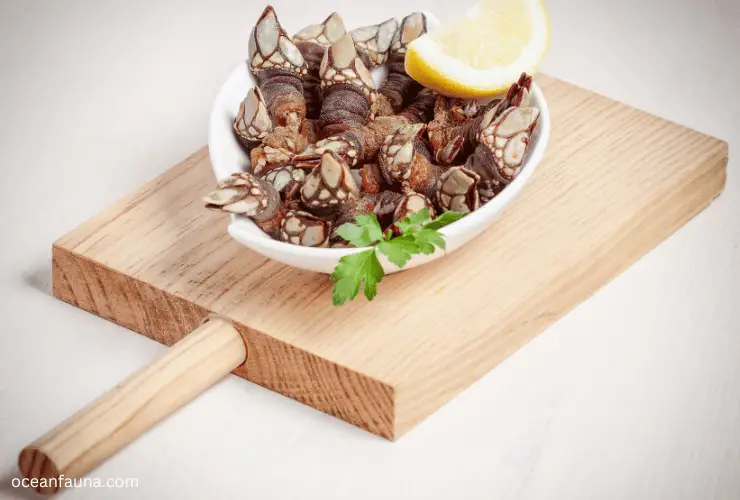
The meat of barnacles is rich in minerals and other nutrients, making it a healthy alternative to other seafood options. The flavour of barnacles is subtle yet distinct, with a delicate sweetness that is unlike any other seafood.
Are Barnacles Nutritious?
Although barnacles may not be commonly thought of as a source of nutrition, they do contain certain beneficial components that make them a nutritious addition to one’s diet.
Specifically, barnacles provide essential fatty acids such as polyunsaturated or monounsaturated acids, which are important for maintaining overall health and wellness. These fatty acids have been linked to a reduced risk of cardiovascular disease and improved brain function and mood regulation.
In addition to their fatty acid content, barnacles also contain various minerals essential for good health. These minerals include potassium, selenium, magnesium, calcium, and iron.
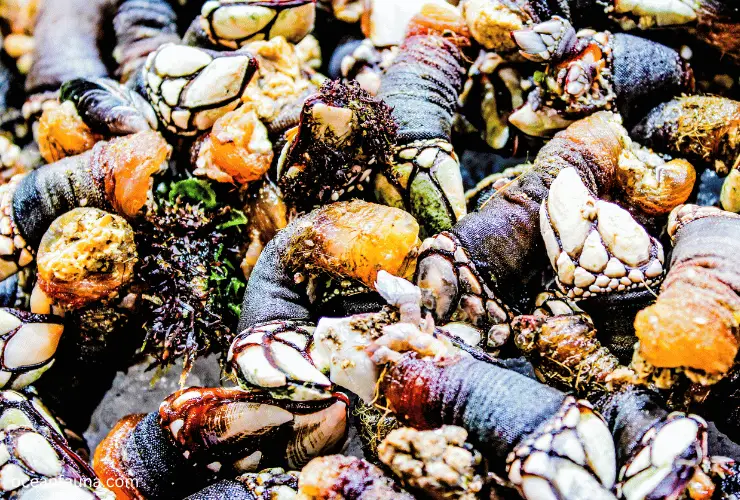
Potassium is important for regulating blood pressure and supporting nerve function, while selenium plays a key role in supporting the immune system and protecting against oxidative stress.
Magnesium is essential for good bone health, and calcium is important for strong teeth and bones.
Finally, iron is necessary for the production of haemoglobin, which carries oxygen throughout the body.
Interestingly, recent research has revealed that barnacles also contain a novel protein of 993 amino acid residues, which makes up the major component of the barnacle cement protein complex.
While the nutritional benefits of this protein are not yet fully understood, its discovery suggests that barnacles may contain even more beneficial components than previously thought.
Can You Eat Raw Barnacles?
Yes, you can eat raw barnacles. In fact, many restaurants incorporate raw barnacle meat in their ceviches. Barnacle meat is considered a delicacy in some countries and is often used in seafood dishes.
However, it is important to ensure that the barnacles have been properly cleaned and shelled before consuming them. The shells can contain grit and other debris, which can be unpleasant to consume. To prevent this, it is recommended that you thoroughly clean the barnacles before consuming them.
You May be Interested in Are Barnacles Alive? [Explained]
Barnacles are a type of crustacean that is typically found in rocky coastal areas. They attach themselves to hard surfaces such as rocks, shells, and even boats. They are filter feeders and consume tiny organisms such as plankton and algae.
In some countries, barnacles are considered both a delicacy and a traditional food. They are often served raw with lemon juice or in ceviche dishes. Raw barnacles have a unique texture and taste that can be described as both sweet and salty, with a slightly chewy consistency.
How To Prepare Barnacles to Eat?
To prepare barnacles for consumption, start by rinsing them under water to remove any debris or dirt. Next, use a sharp knife or scissors to cut off the feathery appendages sticking out of the shell. The barnacles use these appendages to capture plankton and are not considered edible.
Now that the barnacles are clean and trimmed, it’s time to cook them. To cook barnacles, steam them in a large pot for about 10-12 minutes. Alternatively, you can boil them for the same amount of time. Once they are cooked, remove them from the heat and let them cool down.
How to eat barnacles? You will need to remove the meat from the shell to eat barnacles. This can be done by holding the barnacle with one hand and using the other hand to twist the top shell until it comes off. Then, use a small fork or spoon to scoop out the meat from the bottom shell.
Barnacle meat has a chewy texture and a subtle, briny flavour. Some people like to dip it in butter or garlic sauce for added flavour. Keep in mind that barnacles are high in protein and low in fat, making them a healthy choice for a seafood dish.
If you have leftover barnacles that you can’t eat right away, store them in a dry container in the refrigerator for up to 2 days. Just be sure to reheat them thoroughly before eating. Following these simple steps, you can enjoy a delicious and nutritious seafood meal at home.
Which People Eat Barnacles Most?
Barnacles are most commonly consumed by people living in coastal regions of Spain and Portugal, where they are considered a popular delicacy. The Galician region of Spain is particularly known for its barnacle harvesting and consumption traditions.
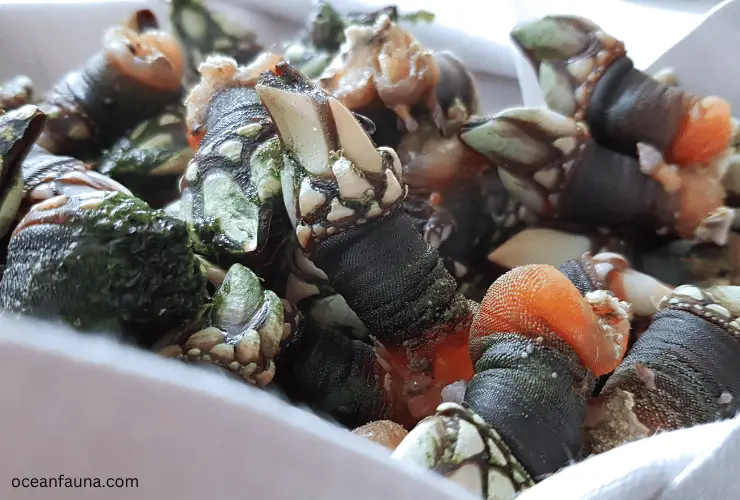
In fact, the barnacles from the Galician region are considered to be of the highest quality and are, therefore, highly sought after in other parts of the world.
While barnacles have been traditionally consumed in European countries for centuries, they are just beginning to appear on menus in the U.S.
Despite this, there is a growing interest in this unique seafood delicacy. With its rich flavour and meaty texture, barnacles are often served as appetizers in high-end restaurants and are usually accompanied by garlic and olive oil.
Barnacles are primarily harvested from rocky shores; the most commonly found variety is the goose barnacle. These crustaceans are known for their tough exterior, which must be removed before consumption. They are typically prepared by boiling or steaming and then served with a dipping sauce made from garlic, olive oil, and other herbs and spices.
While barnacles are not a staple food in many parts of the world, they are still a popular seafood delicacy that people in many coastal regions enjoy. With its unique flavour and texture, barnacles are definitely worth a try for those with a taste for seafood.
Conclusion
Hopefully, you understand that barnacles are completely edible and a safe seafood option. Even one can consume it raw. If you want to know more about the consumption of barnacles, let me know.

